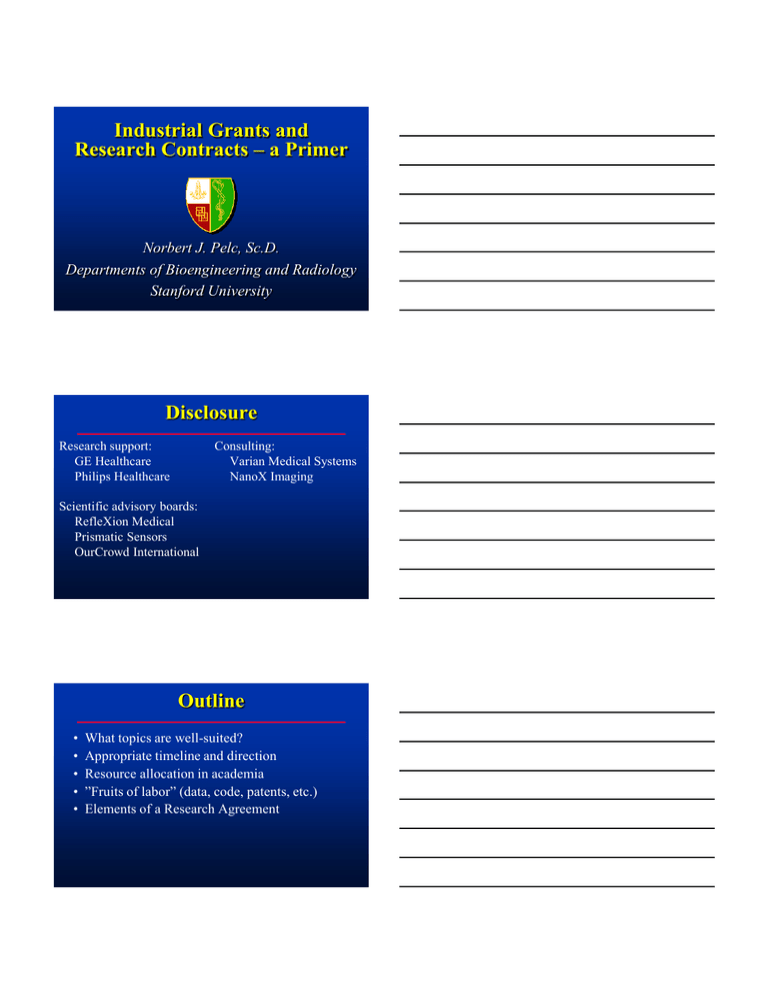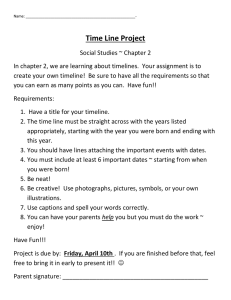Industrial Grants and Research Contracts – a Primer Disclosure Norbert J. Pelc, Sc.D.
advertisement

Industrial Grants and Research Contracts – a Primer Norbert J. Pelc, Sc.D. Departments of Bioengineering and Radiology Stanford University Disclosure Research support: GE Healthcare Philips Healthcare Consulting: Varian Medical Systems NanoX Imaging Scientific advisory boards: RefleXion Medical Prismatic Sensors OurCrowd International Outline • • • • • What topics are well-suited? Appropriate timeline and direction Resource allocation in academia ”Fruits of labor” (data, code, patents, etc.) Elements of a Research Agreement Collaboration topics • Academic's perspective - should be fundamentally interesting to me - should be publishable - get data for follow-up (e.g., NIH) funding • Industry perspective - must be important to my business • Ideal projects meet these criteria Collaboration topics • New technology - flat panel detectors, C-arm CT • Young faculty member with strong interest and expertise • Interested industrial partner • Led to: - new lab - advanced research equipment - new clinical applications - substantial research funding - successful academic career Collaboration topics • Cause for caution for young faculty - topic that is not in your academic vision - requires a clinical collaborator you don't have - work that is not publishable (deal breaker for grad students) - in-kind exchange with high %effort but no $ Timeline and direction • Product development is on tight timeline - industry mobilizes large teams of full time personnel - short deadlines • Academic research is best on slower timeline - small teams, graduate student training, etc. • Some of the best academic research projects are speculative (higher risk, long timeline) • Industry gets highest value from: - less directed, more exploratory work - late stage work, ready for translation product Financial perspectives • Industry perspective - may be an inexpensive way to do R&D • Academia perspective - easy money - free research equipment • Neither perspective is fully true • Each side must understand the needs of the other Resource allocation in academia Funded project must cover: • Research costs - supplies, scan time, animal costs, etc. • Research staff and postdocs • Graduate students (unless on fellowship) - stipend, tuition • Faculty salary • Overhead Fair Market Value Exchange • Evaluation of fair exchange • Each side pays & gets "fair market value" • Necessitated by commercial relationship between the organizations • Used to be easy. Not so any more. • Industry-provided equipment: - easy if only used for company's research projects - complicated if used for other research - very complicated if used clinically Fruits of the labor • Data - sponsor generally gets to use the data • Software (developed under the agreement) - sponsor generally gets to use software for internal evaluations - sponsor generally gets rights to "derivative code", e.g. improvements to industry-provided software • Patent licenses Patent rights- usual terms • Separate license/option for pre-existing IP • Each side owns the IP of their employees • For sponsored work, industry gets - cheap or free nonexclusive license - first right to royalty bearing exclusive license Research Agreement • Single project vs. "umbrella" agreement • Should clearly delineate project - deliverables, schedule, support • • • • • Confidentiality clause Publication clause Intellectual property Indemnification Termination date Confidentiality clause • Needed to protect confidential information (CI) yet easy allow exchange of ideas • Should be 2-sided and balanced • CI protection must extend beyond term of the agreement • Careful with clauses that limit your activities, especially long after the agreement Publication clause • Allowed terms may differ across institutions • At Stanford: - all research can be published - no editorial control by company - short time for company review before/during review to protect confidential info and IP • Read it carefully. It's especially important for your students Summary • Academia-industry collaborations can be very effective - early stage research - translation to products • Choice of research topics is important • Compliance is harder than in the past - not the fault of the company • We need to ensure that these interactions can continue to be achievable
